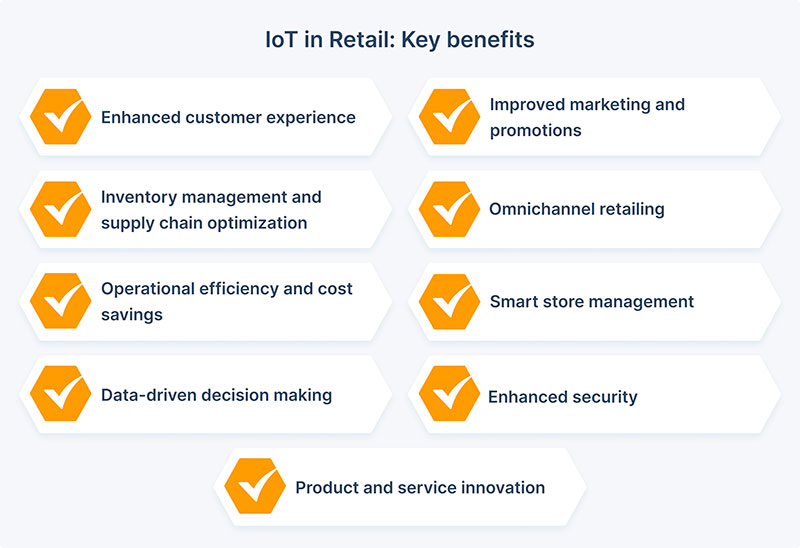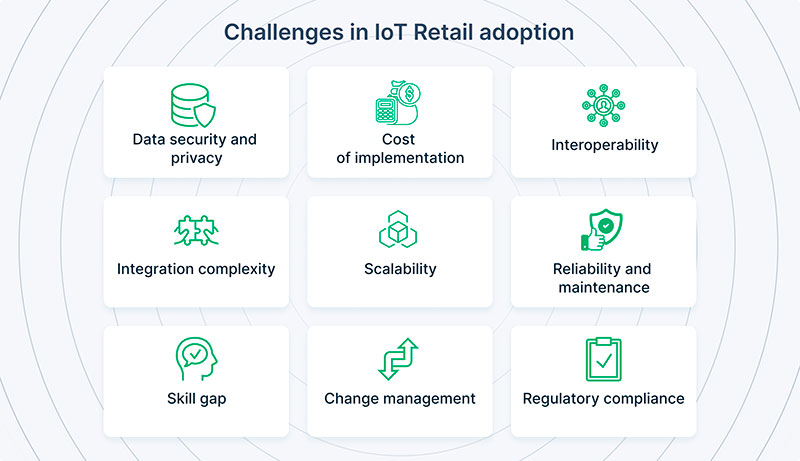IoT in Retail: Transforming Shopping Experiences
January 08, 2024As we navigate the retail landscape in 2024, it's fascinating to note that IoT technology is projected to influence up to 70% of retail businesses, optimizing operations and enhancing customer engagement. The value of IoT in the retail market will be worth $177.90 billion, showing a compound annual growth rate of 20.3% from 2022 to 2031, according to Allied Market Research.
The use of IoT-powered analytics and AI-driven insights is anticipated to reshape how retailers understand consumer behavior, personalize shopping experiences, and streamline supply chain management, fostering a new era of efficiency and innovation within the industry. This surge in interconnected devices and data-driven decision-making promises an even more dynamic and interconnected retail environment, propelling us further into the realm of smart retail solutions.
The way businesses and consumers shop has changed dramatically as a result of the Internet of Things (IoT) and retail industry coming together. In this digital era, IoT for retail isn't just a buzzword; it's a game-changer. From smart connected stores to innovative applications revolutionizing customer experiences, the integration of IoT solutions for retail has unleashed a wave of possibilities.
Join us on an exploration of the profound impact, diverse applications, and promising future of IoT in the retail market, unveiling the key strategies and benefits driving this transformative evolution.
Understanding IoT in retail
In the retail sector, the Internet of Things (IoT) represents a network of interconnected devices, sensors, and systems that collect, exchange, and analyze data, thereby facilitating smarter decision-making and enhancing operational efficiency. IoT in retail sector encompasses a diverse array of applications, from inventory management to customer engagement, leveraging its interconnectedness to revolutionize traditional retail practices.
The relevance of IoT in retail lies in its ability to establish a unified and interconnected retail environment. Smart retail IoT applications include the utilization of sensors to monitor inventory levels in real-time, optimize supply chain logistics, ensure stock availability, and more. Furthermore, IoT applications in retail extend to enhancing customer experiences through personalized marketing initiatives, tailored recommendations, and streamlined checkout processes, thereby fostering increased customer satisfaction and loyalty.
The interconnected nature of IoT devices in retail spaces facilitates efficient data collection and analysis, enabling retailers to make informed decisions, predict consumer preferences, and optimize resource utilization. This interconnectedness leads to operational agility, paving the way for adaptive strategies that cater to evolving market demands and consumer behaviors. IoT's innovative applications in retail stores represent a pivotal shift towards a more responsive, data-driven, and customer-centric retail landscape.
Benefits of IoT in retail

The Internet of Things offers numerous advantages and transformative opportunities for the retail industry. Some of the key benefits include:
Enhanced customer experience
IoT enables personalized and immersive experiences for customers. Through connected devices, retailers can gather data on customer preferences, behaviors, and buying patterns to offer tailored recommendations, promotions, and services.
Iot-knowledge-base/iot-in-retail-transforming-shopping-experiences
IoT sensors and RFID tags help track inventory levels in real time. This data allows retailers to optimize stock levels, reduce out-of-stock situations, streamline supply chain operations, and minimize losses due to overstocking or shrinkage.
Operational efficiency and cost savings
Smart IoT devices automate various tasks, such as monitoring equipment performance, adjusting lighting and temperature based on foot traffic, optimizing energy usage, predictive maintenance for machinery, and overall operational efficiency improvements, leading to cost savings.
Improved marketing and promotions
IoT data analytics enable retailers to gain insights into customer behavior, preferences, and shopping patterns. This information helps in creating targeted marketing campaigns and delivering personalized promotions, improving conversion rates and customer engagement.
Omnichannel retailing
IoT facilitates seamless integration across various channels (online, mobile, brick-and-mortar stores). It enables retailers to provide consistent and synchronized experiences for customers, such as click-and-collect services, personalized mobile shopping experiences, and more.
Smart store management
IoT-enabled devices like beacons, smart shelves, and cameras help retailers monitor in-store traffic, analyze customer movements, optimize store layouts, and improve security, leading to better operational management.
Data-driven decision-making
IoT produces massive quantities of data, which can be analyzed to inform business decisions. Retailers can use this data to understand consumer behavior, predict trends, optimize product placement, and improve overall business strategies.
Enhanced security
IoT technology can enhance security measures in retail stores. Smart surveillance cameras, access control systems, and other connected security devices help keep shops safer for both customers and employees by preventing theft and keeping an eye on any suspicious activity.
Product and service innovation
IoT facilitates innovation by enabling the development of new products and services. For instance, smart wearable devices, interactive mirrors, and connected appliances in retail environments offer novel experiences to customers.
In summary, IoT in retail industry offers a wide array of benefits, including improved customer experiences, streamlined operations, better inventory management, data-driven decision-making, and innovation, ultimately leading to increased competitiveness and profitability for retailers.
Challenges in IoT retail adoption

Adopting IoT solutions in retail presents a transformative journey but is not without its challenges. One significant hurdle is the complexity of integrating IoT into existing retail infrastructures. Retailers encounter obstacles related to interoperability, scalability, and the compatibility of IoT systems with legacy technologies. The adoption of IoT in retail faces several challenges, including:
- Integration complexity. Integrating IoT devices with existing retail systems and infrastructure can be complex. Compatibility issues, different communication protocols, and ensuring seamless connectivity among various devices pose challenges.
- Data security and privacy. IoT devices produce immense amounts of sensitive data. Securing this data from cyber threats and ensuring customer privacy is a major concern. Protecting against potential data breaches and adhering to privacy regulations requires robust security measures.
- Cost of implementation. The initial investment in IoT infrastructure, devices, and systems can be substantial. For many retailers, especially smaller businesses, the cost of implementing IoT technology might be prohibitive.
- Interoperability. Ensuring that different IoT devices from various manufacturers can communicate and work together seamlessly is a significant challenge. Lack of standardized protocols and compatibility issues hinder interoperability.
- Scalability. As retailers expand operations or add more IoT devices, scalability becomes crucial. Ensuring that the infrastructure can handle increased data volumes and device management without compromising performance is a challenge.
- Reliability and maintenance. IoT devices require regular maintenance and updates. Ensuring the reliability of these devices and addressing issues promptly is essential to prevent disruptions in retail operations.
- Skill gap. Implementing and managing IoT systems requires specialized skills. There might be a shortage of professionals with expertise in IoT technology, data analytics, and cybersecurity in the retail sector.
- Change management. Adopting IoT often involves a cultural shift within the organization. Resistance to change among employees, along with the need for training and adapting to new processes, can be challenging.
- Regulatory compliance. Meeting regulatory requirements and standards concerning data privacy, consumer rights, and cybersecurity is crucial. Keeping up with evolving regulations in different regions adds complexity to IoT implementation.
To tackle these obstacles, the retail industry needs to engage in strategic planning, allocate resources, cooperate with technology partners, follow security best practices, and remain dedicated to continuous innovation and adaptation.
Exploring IoT use cases in retail
Exploring the extensive range of IoT retail use cases unveils a transformative landscape where interconnected devices revolutionize traditional practices. These practical applications span across diverse facets of retail, amplifying customer experiences, streamlining inventory management, and revolutionizing personalized marketing strategies. Let’s review how IoT is used in retail industry.
IoT use cases in retail are vividly evident in the emergence of smart connected stores. Through the integration of IoT devices, retailers can offer seamless and personalized experiences to customers. Smart shelves equipped with sensors track inventory levels in real-time, triggering automatic restocking orders when products run low. This ensures shelves are consistently stocked, minimizing instances of stockouts and enhancing customer satisfaction.
Moreover, IoT technologies in retail facilitate enhanced customer experiences through personalized marketing initiatives. Smart IoT-based systems analyze customer behavior, enabling retailers to deliver tailored recommendations and promotions in real-time. For instance, beacon technology assists in sending personalized offers to shoppers based on their location within the store, fostering a more engaging and targeted shopping experience.
Additionally, IoT solutions play a pivotal role in optimizing inventory management practices. RFID (Radio-Frequency Identification) tags and sensors track product movement and expiration dates, allowing for efficient inventory control and reducing wastage. This real-time visibility into inventory levels ensures accurate stock management and aids in forecasting demand, thereby minimizing overstock situations.
The integration of IoT use cases in retail environments showcases the potential for enhanced operational efficiency and enriched customer engagement. Smart connected stores represent the vanguard of a retail revolution, where data-driven insights derived from IoT devices elevate the retail experience, solidifying customer loyalty and driving business growth.
Conclusion
The IoT revolution in retail marks a pivotal shift, reshaping traditional paradigms and redefining consumer interactions. Embracing IoT technologies isn't merely an option. It's a strategic imperative for retailers aiming to thrive in a dynamic market. This transformative wave enables operational optimization, personalized engagements, and innovative experiences, vital for staying competitive.
Retailers embracing IoT unlock a realm of possibilities, crafting a future where seamless integration of technology and customer-centric approaches is pivotal. Embrace the IoT revolution not only to adapt but also to flourish in a landscape where customer experiences and operational efficiency converge for sustained success.
